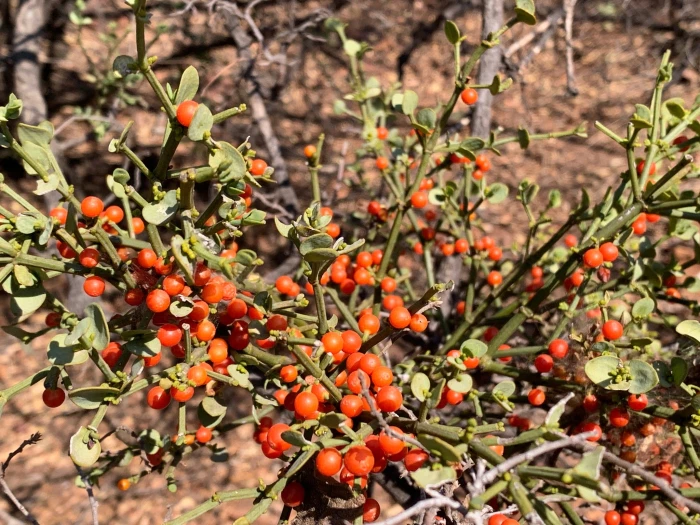Red-Berry Mistletoe
(Viscum rotundifolium)
Red-Berry Mistletoe (Viscum rotundifolium)
/
/

Haneef Tayob
CC BY 4.0
Image By:
Haneef Tayob
Recorded By:
Copyright:
CC BY 4.0
Copyright Notice:
Photo by: Haneef Tayob | License Type: CC BY 4.0 | License URL: http://creativecommons.org/licenses/by/4.0/ | Rights Holder: Haneef Tayob | Publisher: iNaturalist | Date Created: 2022-08-28T08:26:15Z |























Estimated Native Range
Climate Requirements
| • Precipitation | 1" - 49" |
| • High Temp. | 72°F - 97°F |
| • Low Temp. | 28°F - 57°F |
Summary
Viscum rotundifolium, commonly known as the red-berry mistletoe, is an evergreen hemiparasitic plant native to a variety of habitats in southern Africa, including savannas, woodlands, and coastal scrublands. It is found at elevations from near sea level to 6,398 feet (1,950 meters). This mistletoe species is adaptable, parasitizing a wide range of host plants, including Acacia, Eucalyptus, and even other mistletoe species. It has a broad, spreading growth form with fleshy, leathery leaves that are broadly ovate to elliptic. The small creamy-green flowers are inconspicuous, blooming sporadically throughout the year, but the brilliant shiny orange-red fruit stands out and is highly visible when ripe, attracting various bird species that aid in seed dispersal.
The red-berry mistletoe is valued for its adaptability and the ornamental appeal of its vibrant fruit, which can add color to gardens and natural landscapes. It is often used in traditional medicine and has cultural significance in various communities. In cultivation, it requires a host plant to grow on and thrives in a range of light conditions, from full sun to partial shade. It is relatively low-maintenance, given its parasitic nature, but care should be taken to ensure that it does not overwhelm its host. There are no major diseases affecting this mistletoe, but it can become a pest if not managed properly, as it can weaken or even kill its host plants if it grows too vigorously.CC BY-SA 4.0
The red-berry mistletoe is valued for its adaptability and the ornamental appeal of its vibrant fruit, which can add color to gardens and natural landscapes. It is often used in traditional medicine and has cultural significance in various communities. In cultivation, it requires a host plant to grow on and thrives in a range of light conditions, from full sun to partial shade. It is relatively low-maintenance, given its parasitic nature, but care should be taken to ensure that it does not overwhelm its host. There are no major diseases affecting this mistletoe, but it can become a pest if not managed properly, as it can weaken or even kill its host plants if it grows too vigorously.CC BY-SA 4.0
Plant Description
- Plant Type: Shrub
- Height: 1-2 feet
- Width: 1-2 feet
- Growth Rate: Slow
- Flower Color: N/A
- Flowering Season: Spring
- Leaf Retention: Evergreen
Growth Requirements
- Sun: Part Shade
- Water: Medium
- Drainage: Medium
Common Uses
Bird Garden, Low Maintenance
Natural Habitat
Savannas, woodlands, and coastal scrublands in southern Africa
Other Names
Common Names:
Scientific Names: Viscum rotundifolium, Viscum bosciae-foetidae, Viscum glaucum, Viscum macowanii, Viscum thymifolium, Viscum tricostatum, Viscum zizyphi-mucronati
GBIF Accepted Name: Viscum rotundifolium